less_confused
Rough_Rock
- Joined
- Jul 13, 2009
- Messages
- 72
Perhaps both, it can be a matter of profit to cut a diamond to such exacting standards and precision can mean losing more weight during the cutting process, more time and skill which can = less profits. Here on PS we represent a small sector of the diamond buying public who happen to value top cuts and fine make cuts, in the ' real world' different priorities can apply such as carat weight often being the higher priority than cut, colour, clarity etc are also of greater importance to the diamond buyer outside PS anyway rather than cut. From what I understand as of now in the mainstream diamond world, carat weight is of vast importance and the main driving force of cutting plans for most commercial cut diamonds. To me it would appear that consumers are now learning the value of cut quality and more are looking for well cut diamonds so I think we will see more over time but whether cut will become of huge interest in the non PS world....Maybe in time.....hard to say!Date: 7/28/2009 1:54:56 PM
Author:less_confused
Is an Ideal cut a function of the gem cutter or the stone?
The reason I ask is that Ideal cut stones clearly get a price premium. More effort, of course, but higher return.
Shouldn't we see the Ideal cut become more common in the near future?
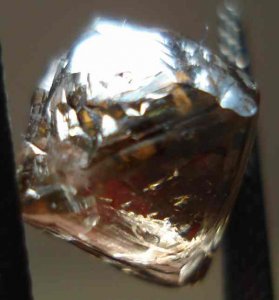
This was nicely explained.Date: 7/28/2009 4:35:53 PM
Author: Judah Gutwein
..It's interesting to note that there is a guy/gal who gets paid a whole lot of money to actually analyze a piece of rough for its best yield. These experts who work for manufacturers, will take a look at a piece of rough before it goes to the cutter and make all kinds of calculations before determining its destiny.
It goes something like this:
What would be the best shape for this rough? Should we turn this stone into a marquise, heart shape etc? Is it even possible to cut this rough into a specific and desired shape? What shape would be most conducive for allowing us to cut 'around' the imperfections within the diamond? If we desire to cut around / away those imperfections or to mitigate them, it involves cleaving the stone into two pieces (of rough) which will result in two smaller (polished diamonds) of better clarity grades. The alternative scenario, would be to leave the imperfections exactly where they are and to fashion the rough into a significantly larger, albeit more included (lower clarity) diamond. Which scenario based upon market forces, will provide us with a better ROI? Which scenario based upon consumer demographics will allow for a quicker turover?
and on and on....
So, it's not exclusively a question of whether ideal cuts will become more common in the near future (they are already quite in demand..for the right customer).
Rather, the complex set of considerations above (and then some..), will also influence at any given time the ratio of available ideal cut diamonds in the marketplace versus diamonds of lesser precision, or of the the more commercial variety.
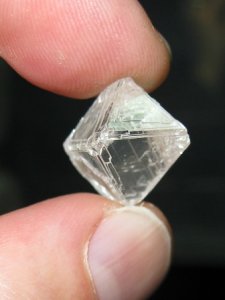

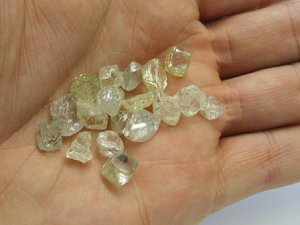
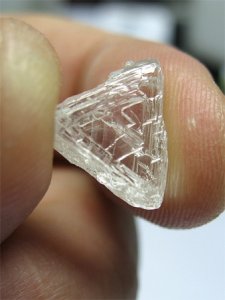

Unfortunately no.Date: 7/28/2009 6:13:27 PM
Author: Rockdiamond
Awesome stone John!!!
Did you guys get it? ( If I may ask)

Last year these type of sizes and qualities were almost impossible to win on offer...Date: 7/28/2009 6:08:24 PM
Author: John Pollard
Adding to RD''s photo example - the octahedron is the most common habit for gem-quality diamonds. In nature they often become rounded, which makes them even more suitable for that shape.
Nice octas are often sawables, a crystal which will yield more if divided into two stones. Here is a photo of a 17ct sawable octahedron we bid on last year.
That is the challenge. If you want a seat at the table and are not at the top of your game in rough analysis, knowing your (hopefully cutting-edge) equipment and market trends - you won't be in it for long.Date: 7/28/2009 6:23:52 PM
Author: strmrdr
To add to the already excellent information here.
It goes back to how diamonds are sold at the beginning of the chain.
Diamond rough is sold based on its potential polished selling price.
I attached a photo of a parcel to show what Karl is talking about.They need to sell the best and the worst so they will sell mixed lots.
Say you want rough that will yield 2+ct D-E/vvs/Ideal RB for 2 diamonds.
In order to get it you have 2 choices:
buy a box or more likely 2 boxes of several other pieces of rough in varying qualities.
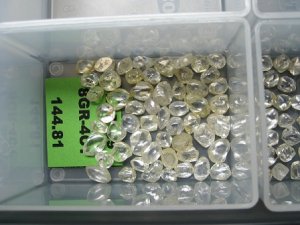
Surprisingly though..., the thangs/dops used are models used for decades already..., very little has changed in that arena...Date: 7/28/2009 6:19:36 PM
Author: Judah Gutwein
'It should do nothing but increase our respect for the old grey-haired cutters who, for generations, did all of this with simple tools under gas lanterns. '
John,
Though they may not be working with lanterns and basic tools anymore, the 'old grey-haired cutters' are still very much a part of our landscape! Here in N.Y.C., I'd say the cutters are evenly split between the new and old guard.
Cutters here don't retire until they are carried out in a box, or until their projected round stone turns into a trillion!!
On a different but related note, it's also worth mentioning that the cutting tools and cutting benches (and facilities) themselves can influence the (quality) output of the diamonds fashioned.
Better diamond cutters who are skilled in the art of cutting Ideals and who do so routinely, will often place much more emphasis on the quality of their cutting tools and benches. Their tools are updated and in pristine condition, their cutting wheels are incredibly well calibrated and their benches are level and virtually vibration free.
Of course, no self-respecting and gainfully employed cutter will operate from a cutting bench that vibrates like a tractor and with tools from the stone age.
However, the care and emphasis placed on the quality and precision of a loose diamond, begins at the cutting wheel.
I was fascinated when I first took a tour of a cutting facility in the suburbs of Belgium, specializing in Ideal cuts.
The factory was in pristine condition (unlike the many factories that look like bomb shelters) and the cutting benches were incredibly and expertly configured. Benches were bolted to a perfectly leveled floor in a specialized and complicated process. Diamond dust from the cutting wheels were individually vented out of the building...etc. etc.
The cutters themselves displayed a great deal of pride in the configuration of the facility, which allows them to work hassle free and with full attention to the complicated task at hand.
So, from conception to birth, it is a detailed and complicated process.....
Yes. Actually we enjoy a little celebrity in that area. Most cutting houses find a use for nearly everything they buy. Their castoffs make nice eBay diamonds. Since we have narrower parametes we sell single crystals that are terrific for other operations.Date: 7/28/2009 6:23:52 PM
Author: strmrdr
John I believe that Paul said he sells 1/2 the rough he buys in his lots to other cutters even after careful selection of lots that most meet his needs?

Attach mp3 ?Date: 7/28/2009 6:57:52 PM
Author: Judah Gutwein
'You cannot take the horses without the carriages'! (sounds much better with the accent...)

You didn't get it remotely wrong Gypsy. And you're always welcome to pick. In fact I learn more when I get to 'splain things, because I wind up revisiting what I'm 'splaining. So please do (you too Kaleigh - I know you're reading this).Date: 7/28/2009 7:45:34 PM
Author: Gypsy
A) COOL I didn't get it totally wrong.
B) Thank you Juddah and RD.
C) Um John... when I'm taking my GIA courses (doing the same thing Kaleigh is) may I occassionally pic your brain? I would greatly appreciate it.

I agree. And no, such geometrically precise specimens aren't so common. That is especially true with alluvial rough (anyone care to explain why?).Date: 7/28/2009 7:46:58 PM
Author: glitterata
That octohedron is gorgeous! Almost a shame to cut it into a mere gemstone. Is it common to find such well formed pieces of solid geometry?
Paul may remember but he's on vacation. It pains me to think about - like losing a lover to another suitor.What spec stone(s) did it end up turning into, do you know?

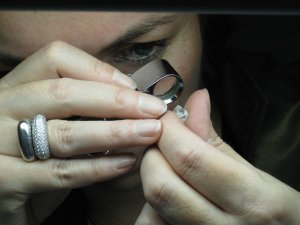
I think a lot of folks agree with you glitterataDate: 7/28/2009 7:46:58 PM
Author: glitterata
That octohedron is gorgeous! Almost a shame to cut it into a mere gemstone. Is it common to find such well formed pieces of solid geometry?
What spec stone(s) did it end up turning into, do you know?

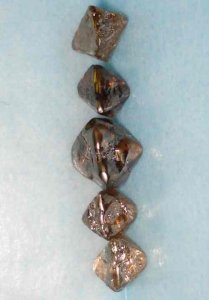
Ding ding ding ding ding.Date: 7/28/2009 9:45:39 PM
Author: glitterata
I love the glossy skin on those brown diamonds, but that 17 ct transparent beauty is my new dream stone. Just the way it is, without any cutting.
John, is the answer to your q. about why alluvial rough is less perfectly geometrical that tumbling through rivers chips and cracks and grinds off the corners?

